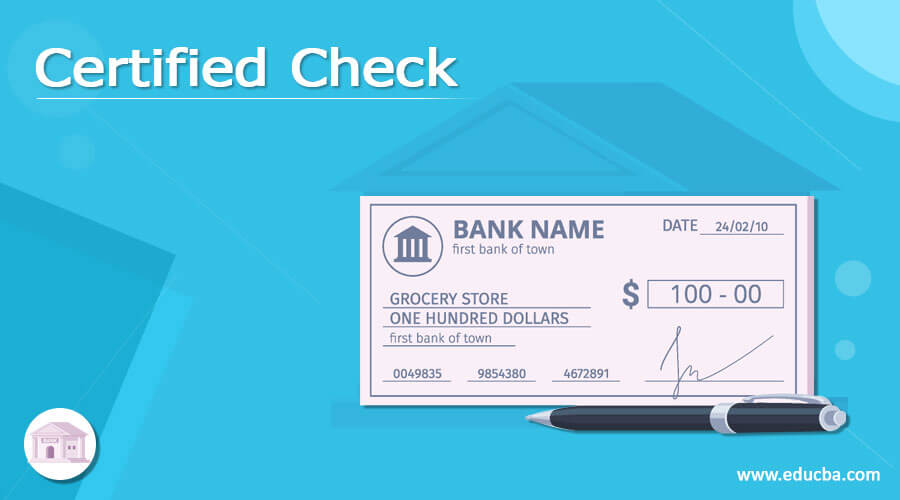Updated July 13, 2023

What is a Certified Check?
A certified check is a check where the account holder’s bank certifies the check and provides assurance concerning the availability of balance in the holder’s account.
It is a check issued by the account holder with confirmation from the bank for the availability of the bank balance. If a certified check is issued, the bank sets aside the specified balance in the account to honor the payment. A certified check is predominantly used to check the account holder’s creditworthiness and ensure that the check doesn’t bounce due to the non-availability of the balance. In addition, it prevents the risk of non-payment as the amount is parked separately. It is usually issued when the transaction involves a significant sum of money. Once a certified check is issued, the stop payment is not possible.
How Much-Certified Check Cost?
A certified check comes at a cost as the bank secures the transaction. In banking terminology, it is called an “Official check.” It comes with a cost of $10-$15; it varies from bank to bank; some bank charges higher than this, and some even provide the check at zero charges. It depends on the bank and customer relationship and the varying bank charges.
How to Get It?
To get this, the account holder should check with the bank first to ensure that they provide the service of issuing a certified check. On confirmation from the bank, the account holder should draw a personal check in favor of the recipient and visit the bank to certify the check. The bank official will verify the bank balance and mark it certified upon visiting the bank. This process will involve some fees, as mentioned above.
Why use a Certified Check?
A check is not a cash payment but an assurance to pay from the bank account. There are always chances for non-availability of funds in the issuer’s bank account, and the check can bounce. To avoid this risk, it is issued where the specified amount will be parked separately in the account on the issuance of a check. The bank will issue this only after verifying the account balance. It is used when a significant value of money transaction happens to secure the payment. (e.g.) Payment for purchasing any asset like a house, car, etc., or settlement of any debt.
Avoiding Certified Check Scams
There are a lot of scams happening with checks, one of the common scams with a certified check is issuing fake or duplicate checks for making payment for purchase transactions.
(e.g.) In case of issuing it against a purchase made from an unknown vendor. So the recipient party doesn’t know the issuer of the check-in person, so he provides the product and accepts the check. But, when he tries to cash the check, the bank will not accept the same, as it could be a fake check. So, in this case, the seller will lose the product without receiving the money, and it would be tough to trace the purchaser too.
To avoid these scams, it is better not to accept this check from unknown people and try to get the money through other payment methods. However, in case they insist on the check. If the recipient is willing to take the money through a certified check, then it’s better to check with the bank once about this check so that rest assured that the check is original as it is certified by a bank. Later the recipient will not lose the money due to any fraudulent activities.
Certified Check vs Cashier’s Check
There are different types of checks in the banking system. One is a certified check; similarly, another type is a cashier’s check. The bank guarantees both checks and is more secure than personal checks.
In the case of a cashier check, the bank guarantees the fund as the cashier signs the instrument; on the other hand, the certified check is prepared by the issuer, and the bank certifies the same. Both these checks are used in high-value transactions and payments.
Though the bank guarantees both checks, there are differences in their operational ways. In the case of a cashier check, the funds are immediately withdrawn from the issuer’s bank account, and the bank holds it as its responsibility until the payee cashes the check. Then, the funds are transferred from the issuer’s account to the bank’s account, and the cashier’s check is issued.
Whereas in the case of certified checks, the funds will be in the issuer’s bank account, the same cannot be withdrawn to the extent a certified check is issued. The money will remain in the account until the payee cashes the check. Thus, it is more like a personal check drawn against the issuer’s bank account; in addition to the issuer’s signature, the bank representative will also sign the check.
Both checks will bring in changes for the account holder considering the additional secured operation. However, regarding the operational model, the cashier’s check looks even safer as the funds are withdrawn and kept under the bank’s safe custody.
Conclusion
It is one of the secure ways of making payments. It gives a sense of confidence to the recipient of the check as it is signed by a bank representative and comes with the bank seal of “certified” or “accepted.” It is needed only in high-value transactions or when the recipient is unaware of the issuer’s creditworthiness. To be on the safer side, recipients may demand a certified check to ensure the check doesn’t bounce. But considering the fraudulent activities and duplicate checks being prepared, it’s better to cross-verify with the bank once we receive these certified checks.
Recommended Articles
This is a guide to Certified Check. Here we also discuss the definition, cost, and how to get a Certified Check along with its use. You may also have a look at the following articles to learn more –


